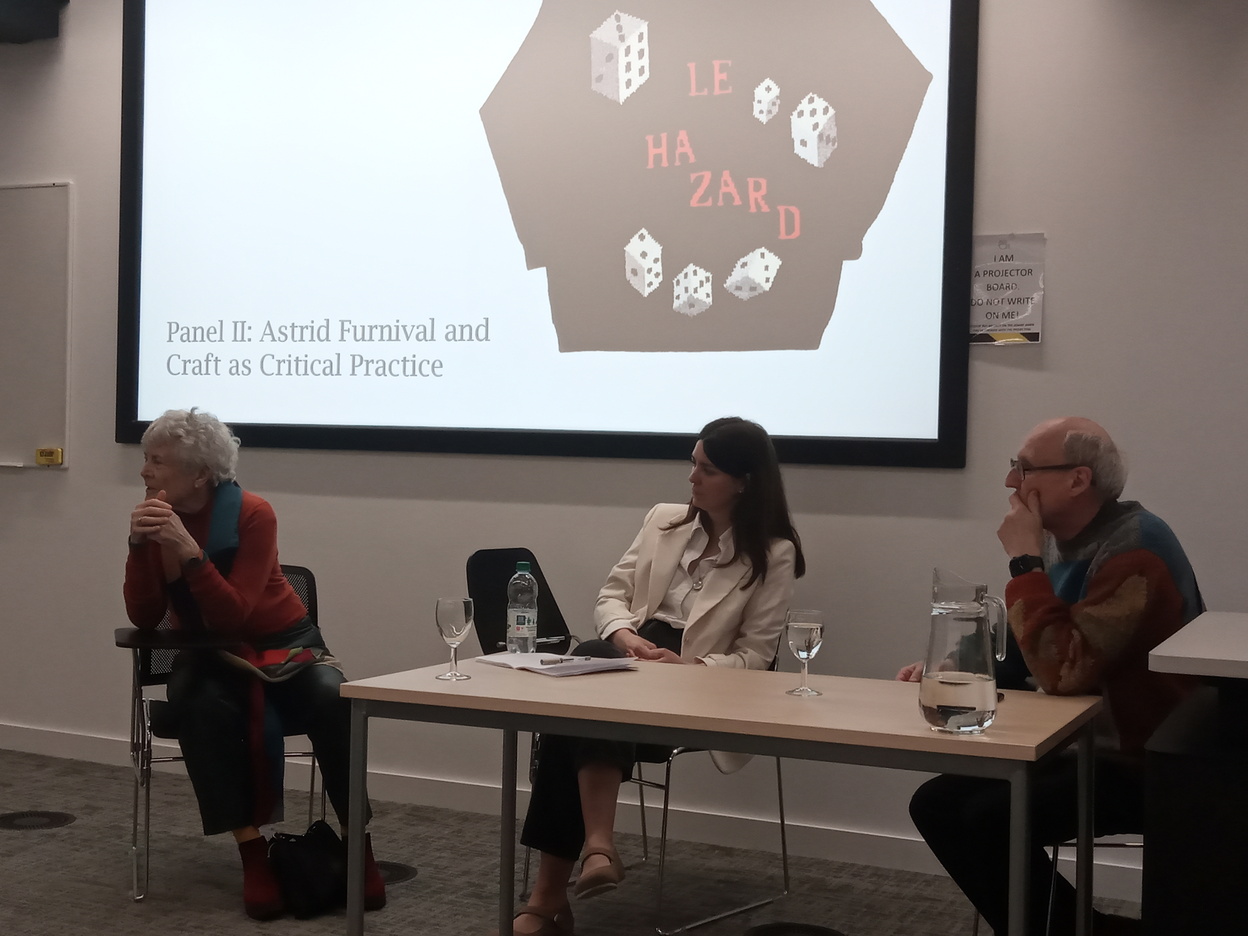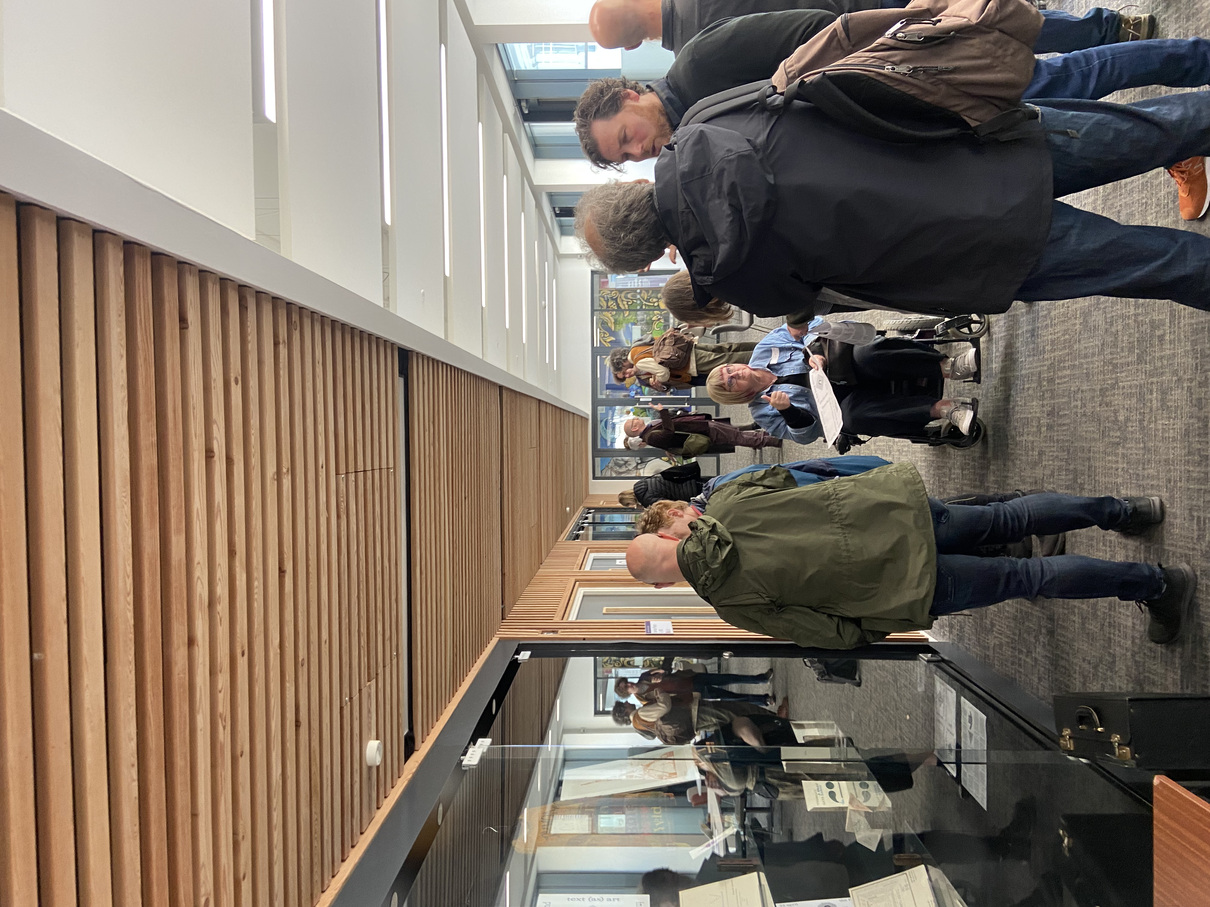Watch Words: The Furnivals and Text (as) Art in the Long Sixties was an interdisciplinary one-day symposium co-organised by Dr. Natalie Ferris, Lecturer in 20th- and 21st-century Women’s Writing at the University of Bristol, and Greg Thomas, arts journalist and author of Border Blurs: Concrete Poetry in England and Scotland (Liverpool UP, 2019). Plans to produce a book of archival materials and essays on the Furnivals are presently underway. It was an opportunity to register the many extraordinary contributions made by the Furnivals to local arts initiatives and educational institutions as well as to national and international movements such as mail art, British Pop Art, Book Art, and the global Concrete Poetry movement. From experiments with the form of the book, concrete poetry, modernist textiles and beyond, the Furnivals made waves, warps and wefts across an array of schools and media, from their base in the little town of Nailsworth. Meanwhile, John taught generations of artists at Gloucestershire College of Art and then at Bath Academy of Art.

The Furnivals were also great collaborators, and inveterate citers and recyclers of others’ words and ideas, not least through their typically humorous Satie’s Faction project, which riffed on the life and legacy of the proto-minimalist composer Erik Satie, and their well-documented – indeed, well-printed and well-woven – love of James Joyce and Samuel Beckett. John’s friends and contemporaries at the Royal College of Art, where he studied in the late 1950s, included David Hockney and Ron Kitaj, while during the 1960s he formed creative connections with the concrete poets Ian Hamilton Finlay and Dom Silvester Houédard, forming Openings Press to publish mailable visual poetry with Houédard and the typographer Edward Wright. He was influenced by the artist Liliane Lijn in his step into so-called Poem Machines, and we were delighted to present a conversation between Liliane and Bronac Ferran as part of our programme. Lijn reflected on this early period in her artistic career (1960s-1970s) tracing the legacies of her experiments with motorised poems and structures. We were also thrilled to be able to hear from Ann Noël , a significant figure in Fluxis and CalArts, via video call from her home in Berlin, on her experience of studying with John and working with Hansjörg Mayer.
Astrid Furnival’s singular textile-based practice, meanwhile, might be seen as part of a sometimes overlooked tradition of modernist textile art. This tradition has been the subject of renewed attention over the last few years, not least through major exhibitions celebrating figures such as Cecilia Vicuña, Anni Albers, and Sheila Hicks. Like another great fibre-artist, Hanna Ryggen, Astrid dyes her works with plants from the family garden. The connections to botany and natural cycles in her practice, combined with its unique emphasis on textile as text, are amongst the many reasons why Astrid’s work is due critical revaluation of the kind afforded to the figures just named.
.png)
We were very lucky to welcome two keynote speakers, the writer Eley Williams, the author of Attrib. and Other Stories and The Liar's Dictionary and recently named one of Granta's Best of Young British Novelists, and Professor Stephen Bann, Emeritus Professor of History of Art at the University of Bristol and editor of Concrete Poetry: An Intenational Anthology (1967). Professor Bann opened proceedings with a wide-ranging exploration of John Furnival's publications and publishing initiatives (such as Openings Press) and one of his most productive decades, the 1960s. Eley Williams closed the day with her pathfinding 'A is for — : An attempted abecedarian account, by concerted dedication, elucidating Furnival', a critical-creative exploration of John Furnival’s output, considering concepts of labyrinths and wanderings, the labour of craft, flippancy as affect, and monumental ephemera as figured in the artist’s archive.
Our three panels explored, broadly speaking, three aspects of the Furnivals’ life and legacy. The first, our morning session, focused on cultural contexts for the Furnivals' work in the 1960s-70s, foregrounding collaboration and pedagogy, with Bronac Ferran on the interconnections between John Furnival and Hansjörg Mayer, Bill Allen offering us a 'tactile interlude with archival materials', and the artist Ann Noël on her experimentation with language and working relationships of the period. Second, a shift to thinking about Astrid Furnival’s work as part of a panel with Bernard Moxham on the Furnivals' shared creative endeavours and sense of humour (appropriately attired in one of Astrid's jumpers) and Rebecca Kosick on the interplay of text and textiles and the ways in which 'responsiveness' characterises her practice. Finally, our third panel considered contemporary critical and creative responses with Leonello Bazzurro on the mixing of media and languages in The Fall of the Tower of Babel and Nicola Simpson with her 'ode to friendship', exploring correspondence, portraiture and performance. Full abstracts can still be found here: https://thefurnivalssymposium.wordpress.com/schedule/

Professors Stephen Bann and Bernard Moxham also generously donated several works to our small exhibition exploration the Furnivals and collaboration, featuring work produced with fellow practitioners such as the Furnivals, Ian Hamilton Finlay, and Tom Philips.
We’d like to extend our thanks to everyone who contributed to the day: all of our speakers and interviewees, the wonderful design team Bricks from the Kiln who have supplied our visuals, the Paul Mellon Foundation who are funding us, Bernard Moxham and Stephen Bann, Bristol University English Department and the Bristol Poetry Institute through Rebecca Kosick, who’s been a great help with our organisational plans, Rob Harris for helping us with set up, and, above all, Astrid, who can’t be with us today but whose vital presence was evoked throughout the day. We would also like to thank our attendees, who offered rich ground for discussion.

